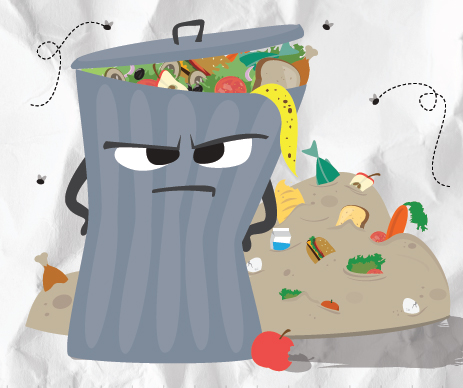Reducing Food Waste
How much food waste is generated?
-
 Between 30 - 40% of ALL edible food is tossed in the U.S.
Between 30 - 40% of ALL edible food is tossed in the U.S. - As much as 20 pounds per person per month is wasted.
- We throw away about 28% of just fruits and vegetables
- 36 million tons of food is wasted while 49 million people are hungry
- Americans throw out the equivalent of $165 billion in food each year
How to Cut Food Waste and Maintain Food Safety - Food and Drug Administration
Let's Talk Trash. - USDA ChooseMyPlate
How Can YOU Reduce Food Waste?
Shop Smart: Buy What You Need
- Keep a running list of meals you enjoy and their ingredients.
- Inventory your refrigerator, freezer, and cupboards to avoid buying food you already have.
- Plan your meals before you go shopping and make a list. Buy only the quantities you need.
- Make your shopping list based on how many meals you'll eat at home.
- Include quantities needed to avoid overbuying. For example: salad greens - enough for two lunches.
- Buy in bulk only if you are able to use the food before it spoils.
Store Smart: Cupboard, Refrigerator, Freezer
Store all foods for maximum freshness; they’ll taste better and last longer, helping you to eat more of them. Use these resources to help guide your storage decisions.
- Safe Food Storage: The Refrigerator and Freezer
- Safe Food Storage: the Cupboard
- Cook to the Right Temperature
- Refrigerate Promptly
- Refrigerator Thermometers: Cold Facts about Food Safety
- Meat Product Labeling and Marketing: What Do All Those Words Really Mean? - Kansas State University
- Food Product Dating: What Do Those Dates Mean?
- Food Product Dating - USDA
Prep Smart: Prep Now, Eat Later
- Freeze food such as bread, sliced fruit, or meat that you know you won't be able to eat in time.
- Cut time in the kitchen by preparing and freezing meals ahead of time.
- Prepare and cook perishable items; freeze them for later use. For example, bake and freeze chicken breast; fry and freeze taco meat.
Save Smart: Eat What You Buy
- Shop your refrigerator first! Cook or eat what you already have.
- Have produce that's past its prime? Use for cooking. Think soups, casseroles, stir fries, sauces, baked goods, pancakes or smoothies.
- If safe and healthy, use food you normally do not eat. For example, stale bread can be used to make croutons, beet tops can be sautéed for a delicious side dish, and vegetable scraps can be made into stock.
- Learn the difference between "sell-by," "use-by," "best-by," and expiration dates.
- Are you likely to have leftovers? Plan an "eat the leftovers" night each week. Casseroles, stir-fries, frittatas, soups, and smoothies are great ways to use leftovers.
- At restaurants, order only what you can finish. Take home the leftovers for your next meal.
- At all-you-can-eat buffets, take only what you can eat.
Source: Reducing Wasted Food at Home
For more resources on reducing food waste, go to the K-State Research and Extension Food Safety website
Compost is Cool!
Food Keeper App
The FoodKeeper helps you understand food and beverages storage. It will help you maximize the freshness and quality of items. It was developed by the USDA's Food Safety and Inspection Service, with Cornell University and the Food Marketing Institute. It is also available for Android and Apple devices.

